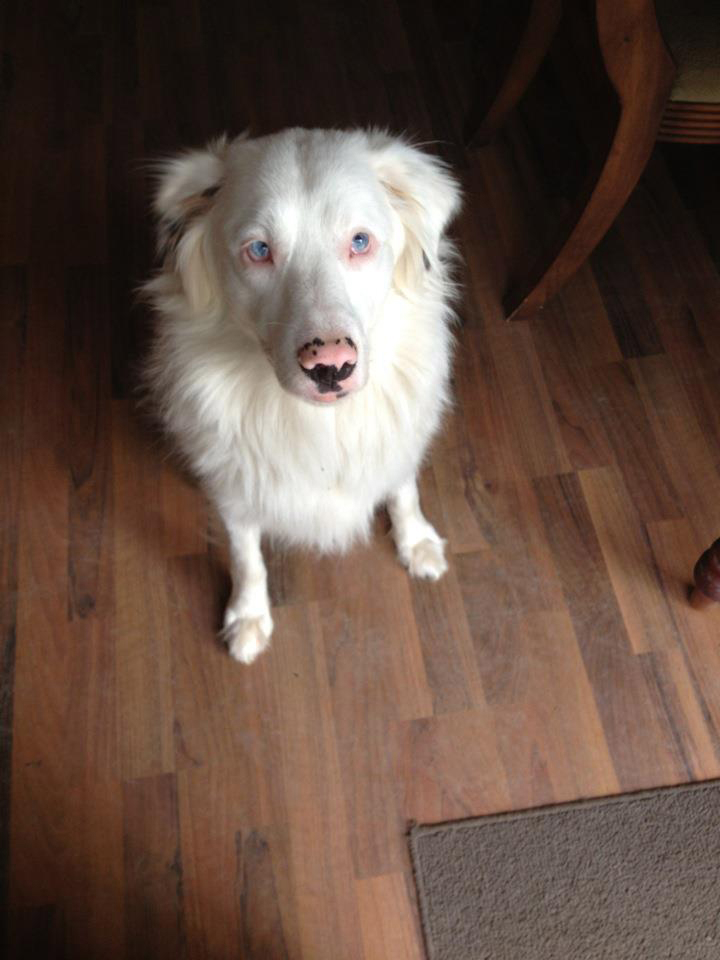In July of 2011, my husband and I adopted a 5-month-old Australian shepherd from the Oregon Humane Society. We named her Asha — Sanskrit for “hope and life.” We thought the name was appropriate.
You see, Asha was born blind and deaf. She is one of many such Australian shepherds born each year, the result of irresponsible breeding. They are called double merle because when two merle-patterned Aussies are bred, there is a 25 percent chance the offspring will be blind and deaf. Some are just blind, some deaf, some both. They are also called lethal whites because they are all white (with some brown and black spots) and they are most often killed.
Asha was part of a litter of seven puppies, all deaf and blind. When the breeder realized this, he drowned the puppies. He killed four of them before his wife stopped him. She took the surviving three to the Oregon Humane Society. They could only take one. We are unsure what happened to the other two.
Asha now lives with us, our two other dogs and three cats. And what a life she has!
Many people ask, “What do you do with a blind and deaf dog?” We do everything you would do with a seeing and hearing dog. It takes more time and energy, but Asha is very smart and won’t let anything stop her. If you ran into us on the street or in a store, you would not realize that Asha is blind and deaf. She navigates the world quite easily. She can map out a new space in minutes. She runs through our house without hitting anything. She jumps off the back deck, climbs the stairs to the second floor and jumps on and off the couch without missing a beat.
Asha loves to meet new people. She is very social and not afraid of anything. Just last week, we made our first visit to the Vancouver Farmers Market. At first, she was overwhelmed by the smells and the energy of the place. I sat with her for a minute at the edge of the market. I petted her and told her it was okay. Soon she was ready to take on this new adventure, to color a new page in her book. We wandered the street, visiting with vendors, smelling the plants, meeting the other dogs out for a Saturday stroll.
Asha is also epileptic and has some neurological issues. We work with a behavioral vet, an acupuncturist and a food therapist to help her feel more stable. We have seen tremendous progress in the last 10 months. We look forward to seeing even more as the months pass and Asha grows.
Everyone who meets Asha loves her. We visit the local Petsmart several times a week, and everyone there knows her. She makes the rounds and thinks she owns the place. She is always ready to roll over and get belly rubs or to sit for a treat. We are always happy to tell Asha’s story, to let people know about irresponsible breeding practices and how she is no less of a dog because she’s different.
Asha was a throwaway dog. She is only alive because she wasn’t the closest to her breeder when he started reaching for puppies to drown. While I am not sorry she exists, I am sorry that most dogs like her never have a chance not only to survive, but thrive. She is strong and happy, confident and inquisitive. She shows me every day that life is worth living and despite any circumstances, you can be happy.
Everybody Has A Story welcomes nonfiction contributions, 1,000 words maximum, and relevant photographs. Email is the best way to send materials so we don’t have to retype your words or borrow original photos. Send to neighbors@columbian.com or “Everybody has a Story,” P.O. Box 180, Vancouver WA 98666. Call Scott Hewitt, 360-735-4525, with questions.



